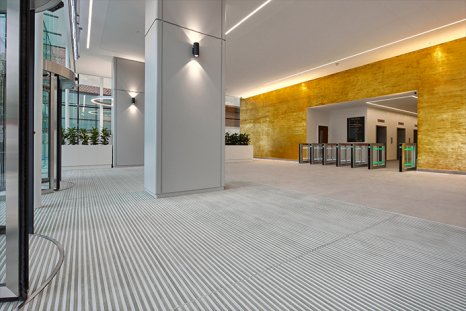Overview
Ensuring the safety of visitors and staff at a building entrance is critical in making a positive first impression. To help prevent slip, trip and fall accidents, the entrance flooring should not present a hazard to the user in normal use and should not become slippery when wet. With the main source of wet contamination at entrances being water carried on footwear and tyres of wheeled traffic, a suitable entrance matting system is vital in removing and retaining moisture to stop it being transferred to internal floorcoverings.
Key Stats
• According to the Health & Safety Executive, 90% of slip accidents in public buildings occur on wet floors.
• An effective matting system can reduce the amount of dirt and moisture tracked into a building by up to 90%, helping to reduce such slip accidents.
• More than 70% of dirt and moisture in buildings is tracked in by pedestrian and wheeled traffic.
A study of pedestrian flow rates at entrances has been undertaken by the Health & Safety Laboratory (HSL) and the Entrance Flooring Systems Association (EFSA), simulating the use of entrance matting to quantify water removal using a laboratory test method developed by EFSA. The findings showed six main points should be considered when choosing an entrance matting system.
1. Peak Flow Rate
Peak flow rate, also known as ‘volume of traffic’ predicts the concentration of traffic and identifies the key times of day when people enter or exit the building.
Example 1: School
• Two main times of day when a heavy concentration of traffic enter or exit the building
• Specification - heavy duty mat to cope with a high flow rate
Example 2: High Street Shop
• Consistent flow of traffic
• Specification - secondary barrier matting used in conjunction with a primary mat to increase moisture removal. The provision of overhead heaters can also help with the evaporation of moisture to speed up the drying time of the mat.
2. Width of Matting
Matting should cover the entire entrance of a building, including any side entrances.
As the first point of contact and, therefore, the first opportunity to stop dirt and moisture being tracked into any building, traffic should not be able to avoid the entrance matting. In some instances, certain entrances are favoured, i.e. those close to toilets, canteen areas or entrances that have automatic doors, so it is important to ensure all access points are covered. A larger quantity of matting at the favoured entrances is advised in these circumstances to guarantee an adequate amount of matting is provided to cope with the level of traffic
3. Length of Matting
HSL and EFSA have provided guidelines concerning the length of matting that should be installed, based on the number of people entering a building per hour*. Though it is accepted that fitting the recommended amount of matting may not always be possible. For example, a high street travel agent may only be able to accommodate a small primary entrance mat due to the size of the premise they typically occupy.
Using secondary barrier matting as a floorcovering to support the entrance mat provides an ideal solution in these situations to increase dirt and moisture removal.
It is crucial to specify enough matting from the outset as modifying the entrance can be costly once the mat / matwell are installed.
*Flow Rate People Per Hour Minimum Lengths:
• Low = 78 people 3-4 metres
• Medium = 400 people 6-7 metres
• High = 800 people 8-10 metres
4. Environmental Factors
The external environment has an impact on the matting that is selected e.g.
• Does the entrance come straight off the street?
• Is there a canopy to shield the entrance from elements such as wind and rain?
If not, specify a heavy-duty entrance mat that will be able to cope with harsher levels of dirt and moisture ingress. If under-specified, the mat will soon become saturated and unable to retain any more moisture, and as a result, contaminants will be tracked onto surrounding floorcoverings, increasing the risk of slip, trip and fall accidents.
5. Type of Traffic
Matting should be suitable for both foot and wheeled traffic to meet the latest guidelines. It is the level of each type of traffic, however, that needs to be considered to provide the optimum specification for the environment.
Example 1: Office
• Most of the traffic is likely to be pedestrian with a low volume of wheeled traffic
Example 2: Supermarket
• A high concentration of both wheeled and foot traffic would be expected
6. Sustainability
Sustainability is now a key factor for consideration in all building design. Products that support the environment, such as those with a high recycled content or those that have a high BREEAM rating, are favoured over those that are not as environmentally friendly.
Gradus Boulevard 6000 barrier matting has been BRE certified whilst Tyreguard primary matting incorporates 100% recycled wipers made from aeroplane tyres. We also use ECONYL, which makes use of old fishing nets. These are our ranges that currently contain ECONYL:
Primary Barrier Matting
• Esplanade 6000
• Esplanade 5000
• Esplanade 1000
Secondary Barrier Matting
• Boulevard 6000
• Boulevard 5000
• Boulevard Stripe
Hybrid Barrier Matting
• Mat-in-a-Box 6000
• Mat-in-a-Box 5000
The study also highlighted some common errors when specifying matting, which can be detrimental to an installation. Avoid the following…
• DON’T use throw down mats
• DON’T leave a gap between the entrance and the matting
• DON’T use mats that impede the movement of wheelchairs (or other wheeled vehicles), i.e. Coir
• DON’T forget to clean the mat to maintain its effectiveness



